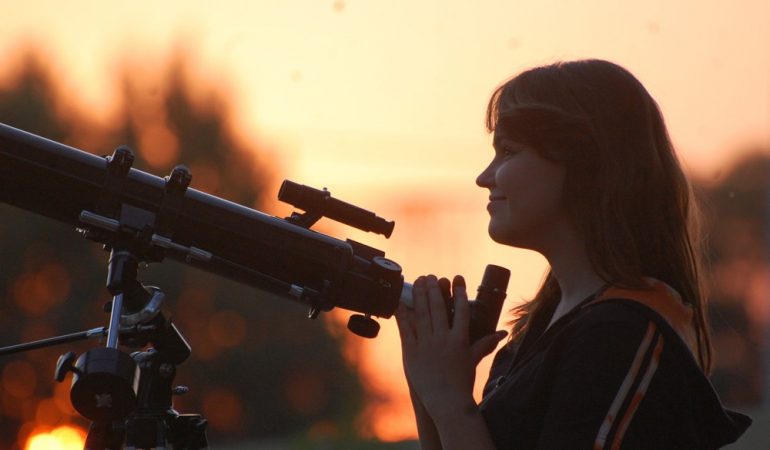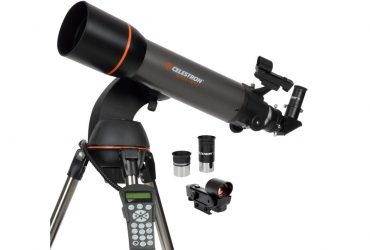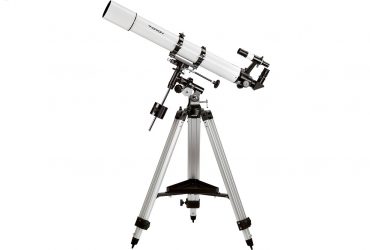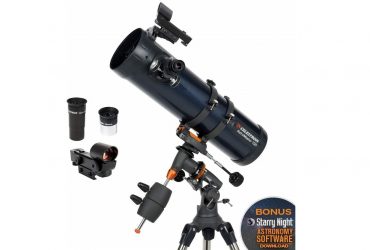Guide to Choosing the Best Telescope for Beginners
If you are a beginner in stargazing, or are contemplating the idea of taking your hobby to the next level and buying a new telescope in the process, you may probably feel that this is a difficult choice to make, due to the large variety of options.
To simplify your choices, we did a research among the best beginner telescopes on the UK market and discovered Celestron 22202 AstroFi 102 Wi-Fi Maksutov Wireless Reflecting Telescope as being the best overall option, having an innovative yet easy to use design and Celestron 11068 NexStar 6 SE Computerised Telescope as the best upgrade, being a high performance computerized telescope.
If you are on a budget and would like to try a high-quality Dobsonian Telescope, Orion 08944e 48x BLACK Reflector Telescope would be a great deal.
What You Should Know When Choosing a Telescope
Telescopes require patience, knowledge and pretty big investments. So before buying one, you may want to think about what is important for you, what do you want to look at, if it’s going to be just for astronomical use or also for terrestrial viewings and how dark the sky in your region is.
Apart from this, you’ll also need to consider how experienced you are in observing stars, how much you can spend, where you can store it, if you want portability or not, as well as how heavy is too heavy for you. Knowing these things will help you make an important first step.
Secondly, when starting the research, it’s essential to know what the key features of a telescope are and what makes one better than the other – especially as a beginner. Here are some basic characteristics of a good telescope:
i. Aperture
Aperture is the diameter of its main component, which can be a lens or a mirror. It is considered to be a crucial quality for telescopes, as it determines both its ability to gather light (the visibility and brightness of the image) and its resolving power (the sharpness of the image).
While a large aperture helps the scope capture maximum light, choosing the telescope with the biggest aperture may be not the best choice. You may want to know that the larger the aperture, the larger the telescope. Having said this, remember that large telescopes are not suitable for everyone, especially if you want to be able to carry it around.
ii. Magnification
Magnification or the scope’s “power”, is important but not an essential feature, and should not influence you when buying a telescope. Why? Because basically, any telescope can provide an infinite range of magnifications, but it all depends on the eyepiece you use. To change the magnification, you just have to replace the existing eyepiece with one that has higher magnification.
So you shouldn’t get excited about telescopes with so-called high magnification, because an excess of it, lacking suitable lenses, can ultimately blur your image. As a rule of thumb, a good magnification degree will be 50 times your telescope’s aperture in inches, or twice its aperture in millimeters (in perfect conditions).
iii. Mount
A stable mount is also very important, as it provides you with the opportunity to follow a star while viewing it. There are two basic mounting systems: equatorial mounts and alt-azimuth mounts. For beginners, the first type of mount is easier to use, as it allows you to follow the rotation of the sky as the Earth turns. The second one is not bad either, as it will require you to develop new skills.
iv. Finderscope
A finderscope is a pointing device that will allow you to point the telescope at a specific area or object that you would like to observe. Without it, locating simply by looking into the telescope would be very difficult.
v. Telescope Type
The telescope type may interest you too. There are 3 classes of telescopes : reflectors, refractors and catadioptrics (a combination of both). Before choosing one, you may want to make some research about what each type brings to the table and see which one suits you the best.
As a beginner, you may want to not spend a fortune on complicated telescopes, that are difficult to use and/or set up, or on something that doesn’t fit your needs. You will want to choose something that will be easy to operate, will have a beginner-friendly design and will ideally come with a well-written user manual – maybe even with a sky database or a digital map, to give you some help in researching the sky.
And remember: the best telescope is the one you use the most.
A Brief Review on the Best Beginners Telescopes
1. BEST OVERALL: Celestron 22202 AstroFi 102 Wi-Fi Maksutov Wireless Reflecting Telescope
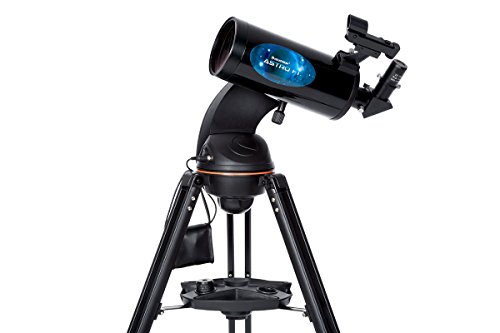
Pros
- Easy to install and setup
- Easy to use; can be controlled via Wi-Fi through the free Celestron sky portal app for iPhone, iPad and Android devices
- Lightweight
- Star Pointer finder scope, 2 Kellner eyepieces, and mirror star diagonal
- Award-winning Star Align technology
- Small and easy to carry
Cons
- Can be a little bit difficult setting it up and aligning it
- There may be WiFi disconnections
- The app that controls the scope disconnects from the telescope once you leave the app
- There may be issues with autocalibration
Overview
The Astro Fi 102 mm Maksutov-Cassegrainne is an entry-level telescope, with an innovative design. It can be controlled entirely via wireless with the use of its free app, installed on your phone (or other device).
In order to use it, you just have to hold your smartphone up, in the direction of the sky. When finding an object you want to observe, just tap on it, and it will be found by the telescope, while your phone screen will display information about it.
Due to the fact that the scope generates its own wireless connection, you can connect to it and use it anywhere.
It has a 90 mm Refractor will fully coated glass-optics. It comes with an accessory tray with 2 x 1.25 inches eyepieces, various accessories, including a rubber-lined area for a smartphone or small tablet.
What It Does Best
This telescope is easy to use and offers great views of the Moon, planets, the rings of Saturn, the Red Spot on Jupiter, the Orion Nebula, the Hercules Globular Cluster and many more.
Its great Sky Align Technology makes it easier to observe the sky and calculate the position of the stars. It also offers the possibility to generate a sky tour of all the best celestial objects to view based on the user’s exact time and location.
Flaws but Not Deal Breakers
According to some reviews, setting up and aligning the telescope can be difficult. The telescope may also have a narrow view. Also, a number of customers complain about the often disconnections of the WiFi, which makes it impossible to use the telescope, and also about the fact that once the phone app is closed, the telescope is disconnected from the phone. But there are solutions to any issue, and these inconveniences are small in comparison to the telescope’s benefits.
What Other Customers Think
Although this telescope wasn’t purchased by many, most of the customers consider it a great investment, and are satisfied with its ease of use, optics and hardware, as well as with its innovative design and resourceful app.
Should You Buy It?
If you are searching for a good entry-level telescope that is easy to use, setup and carry, with an innovative digital design and wonderful optics, then the Astro Fi 102 mm Maksutov-Cassegrain will be an excellent option.
2. BEST UPGRADE: Celestron 11068 NexStar 6 SE Computerised Telescope
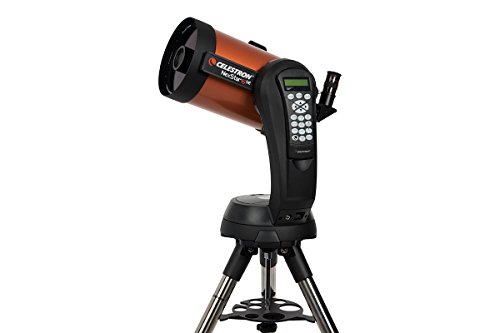
Pros
- Easy no-tool setup
- Lightweight and ultra portable
- Has a high functioning computerized operating system, can be controlled from your computer
- Easy to align
- Has high quality coatings
- Has a 1500mm focal length
- Sturdy tripod
- Comes with an enormous celestial object database
Cons
- Alongside with the product, you will need to buy a power adapter
- Beginners may experience difficulties in using it
Overview
The Celestron 6 SE is a 6″/150mm Schmidt-Cassegrain (reflector-refactor) GoTo computerized telescope which combines high performance with portability.
It has high transmission coatings (StrarBright XLT), with the eyepiece focal length of 1:25 mm (0.98 inches), which will gather with 44% more light than 5” scopes, and therefore will provide greater clarity and image sharpness.
Its SkyAlign technology ensures fast and easy alignment. The scope also comes with a database of over 40,000 celestial objects and even a sky tour feature, for those who are eager to discover more. This scope also has a compact design and a sturdy Altazimuth mount.
What It Does Best
If you are passionate about astrophotography, this is the perfect telescope for you. The Celestron 6 SE supports long exposure with its Autoguider port, as well as with its built-in wedge.
This telescope is also a great upgrade because you can operate it from a PC, which may be easier and more convenient (and not only for beginners). This is possible with the NextRemote software. With the remote tracker, the telescope will point to the visible objects in the sky, without any other effort on your part.
It can help you locate any of the 40,000 objects contained in its database. Additionally, its detailed information about over 200 celestial objects and its sky tour feature makes it an amazing learning tool.
Flaws But Not Deal Breakers
If you want maximum portability, you may probably decide to charge it with 8 AA batteries. This is a great feature, but the downside is that the batteries won’t last more than 15-20 minutes. To solve this issue, you can buy a power adapter that will suit your needs and you will never need batteries again.
Also there are users that find the USB interface inconvenient, because of the R32 cable, which apparently is not so common anymore. The instructions may seem a bit complicated for beginners, but there are a lot of online resources to help you with the setup process.
Also, some customers found the package being too big, so it should be carried with a larger vehicle or unboxed in order to be carried with a smaller one.
In our opinion, all these flaws can be remedied and are not comparable to the scope’s qualities.
What Other Customers Think
Customers say this is one of the best general-purpose telescopes available, suitable for “serious beginners”.
Most of the reviewers report having an easy and pleasant stargazing experience, despite any inconveniences.
Shoud You Buy It?
If you are searching for an entry-level telescope with a more advanced, computerized, yet easy to use technology, this is the one. It is also a great choice for those who live in a light-polluted area and still want accuracy in their viewing experience.
This telescope can carry you on sky tours and give you information about celestial objects, enriching your experience, with only a few button clicks. An amazing tool for any serious entry-level astronomer.
BEST BUDGET: Orion 08944e 48x BLACK Reflector Telescope
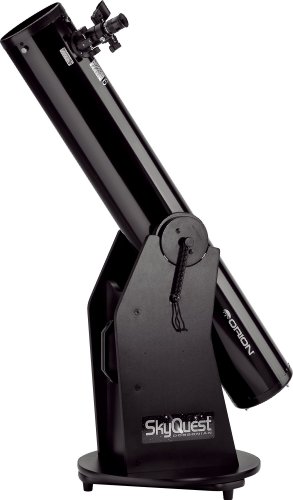
Pros
- Has a big 6″ aperture
- Easy to use, point-and-view navigation, no need to polar align
- The stable base and its smooth motions for tracking ensure a clear image
- Requires little maintenance
Cons
- The tension in the altitude springs can be slightly increased
- The red dot finder may be unpredictable at times
- Big and heavy; difficult to be carried around
Overview
The Orion 08944e 48x is one of the best telescopes to buy if you are on a tight budget, but still want to enjoy a great stargazing experience from the comfort of your home. This scope’s construction makes it easy to use and setup. It has an expert parabolic mirror housed in an enameled steel optical tube. Its Dobsonian base allows easy point-and-view navigation.
It also features a convenient carrying handle, as well as a 1.25 inch Rack-and-pinion focuser, an EZ Finder II aiming device, a 25mm Sirius Plossl eyepiece (1.25″) and a quick-collimation cap
The scope offers sharp focusing (without chromatic aberration) and a vibration-free image.
It comes well-packaged and is really low-maintenance.
What It Does Best
Its main asset is the cost-benefit ratio. It offers clear focused views, even for those who live in cloudy areas.
In terms of targets that can be viewed best, it provides detailed images of the moon (its Kies Pi volcano for example), Saturn with its rings, and even some star clusters.
Flaws But Not Deal Breakers
After purchasing the telescope, there are a few things with which you will have to deal.
The springs for the ‘correct tension’ are a bit too stiff, which may cause some large jerky movements. This can make it really difficult to keep a target in view (for example a planet), when higher magnifications are used.
However, this is easy to fix, you just need to remove one of the tension springs. If you do so, please remember to replace it before moving the scope. Additionally, some users have found that at times, the red dot finder can be unpredictable.
Because the model is a reflector, the diffraction spikes (from the spider vane) are visible when you look at small bright targets.
Another thing that you must know is that it’s a big and heavy scope and it’s also floor-mounted. Even if the scope and its base are separated, transporting it may be challenging, especially for older people.
The telescope is not robotic, which means you will need some preparation and patience in order to locate distant stellar objects. This may be a drawback for some, but for others it’s the most fun part.
What Other Customers Think
Despite its large dimensions, which can be an issue, as well as some other minor flaws, most of its users are very satisfied with this telescope, especially due to its great optics, ease of use and its great quality for an affordable price.
Shoud You Buy It?
Even though Orion 08944e is excellent for a budget telescope, there are still a few things to consider. First of all, make sure you have enough space for it. You will need about 1.5m height and 0.65m x0.65m. Be prepared – it will be more difficult to carry it around.
If you are fine with this, be sure that otherwise the Orion a great choice, ensuring you great sharp views, even during cloudy days and will cause you little hassle, as it is easy to use and very low-maintenance.
